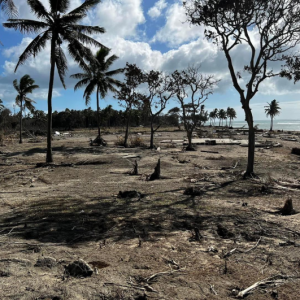Federal Water Tap, January 24: Agencies Outline Spending Plans for Infrastructure Bill Funds
The Rundown
- The Army Corps and other agencies outline how they will spend supplemental funds from the infrastructure bill.
- Two FEMA disaster-prevention grant programs, totaling more than $1.1 billion in funding, have application deadlines this week.
- The Commerce Department seeks information on the environmental footprint of the semiconductor industry.
And lastly, a U.S. Department of Agriculture research agency reports on national irrigation trends.
“One of the things that should be obvious to anybody in this country is that we have a capacity problem on the ground. Notwithstanding the current circumstance that we’re in, even if the world were perfect, you have to say to yourself: Are we ready to build this much stuff this fast?” — Mitch Landrieu, the president’s infrastructure coordinator, speaking at a White House press briefing. Landrieu discussed the challenges of implementing the trillion-dollar infrastructure package, such as assisting communities that need new water systems or roads but might be put off by administrative red tape.
By the Numbers
$22.8 Billion: Additional funding provided to the Army Corps of Engineers through the infrastructure bill and a disaster relief supplement. The Corps outlined how it will spend those funds. Headline projects include $1.5 billion for flood response in four states hit by Hurricane Ida, $1 billion for Everglades restoration, $858 million to complete a lock and dam in western Pennsylvania, and more than $400 million each to complete locks in Kentucky and Michigan.
News Briefs
Infrastructure Plans
Federal agencies are signaling how they plan to spend billions of dollars provided by the infrastructure bill that Congress passed in November.
The Army Corps will complete several lock and dam projects on key rivers like the Mississippi, Ohio, and Tennessee, while also completing a flood-control project in Fargo, North Dakota.
The Bureau of Reclamation will receive $8.3 billion over five years. For 2022, the bureau has not yet selected individual projects for funding, allocating dollars for now only at the program level. As it makes funding decisions, the bureau will be guided by four priorities: water reliability/resilience, racial and economic equity, infrastructure upgrades, and conservation/ecosystems.
Studies and Reports
U.S. Irrigation Trends
Irrigation isn’t what it used to be. A U.S. Department of Agriculture research agency used federal data to identify trends in water use on farms.
The report found a number of shifts. Some are geographic. The share of irrigated cropland in the western states has declined, while it is rising in the Mississippi Delta and Northern Plains.
Some shifts have yet to be made. The report noted that relatively few farmers are using new tech tools such as sensors, flow meters, and equipment that monitors crop health. Broader use of these tools could counteract difficulties with water scarcity.
On the Radar
Deadline Approaches for FEMA Disaster-Prevention Funding
The fiscal year 2021 deadline for communities to apply for two FEMA grant programs is January 28.
The Building Resilient Infrastructure and Communities program has $1 billion to distribute to states, tribes, communities, and territories. The program is intended to reduce the risk of natural hazards like floods and fires.
The Flood Mitigation Assistance program has $160 million to address flood risk for vulnerable structures in order to reduce insurance claims.
Making Computer Chips in the US
Contemporary society — vehicles, smart phones, computers, medical devices — runs on computer chips. Congress is considering hefty subsidies, up to $52 billion in one bill, to fortify the semiconductor industry on U.S. soil, from research and development to fabrication. Meanwhile, Intel announced last week it would invest $20 billion to establish a chipmaking center in Ohio.
In light of this, the Commerce Department is seeking information on a range of questions related to the semiconductor industry, including the industry’s environmental footprint and water demands.
Comments are due by March 25. Submit then via www.regulations.gov using docket number DOC-2021-0010.
Federal Water Tap is a weekly digest spotting trends in U.S. government water policy. To get more water news, follow Circle of Blue on Twitter and sign up for our newsletter.
Brett writes about agriculture, energy, infrastructure, and the politics and economics of water in the United States. He also writes the Federal Water Tap, Circle of Blue’s weekly digest of U.S. government water news. He is the winner of two Society of Environmental Journalists reporting awards, one of the top honors in American environmental journalism: first place for explanatory reporting for a series on septic system pollution in the United States(2016) and third place for beat reporting in a small market (2014). He received the Sierra Club’s Distinguished Service Award in 2018. Brett lives in Seattle, where he hikes the mountains and bakes pies. Contact Brett Walton






Leave a Reply
Want to join the discussion?Feel free to contribute!